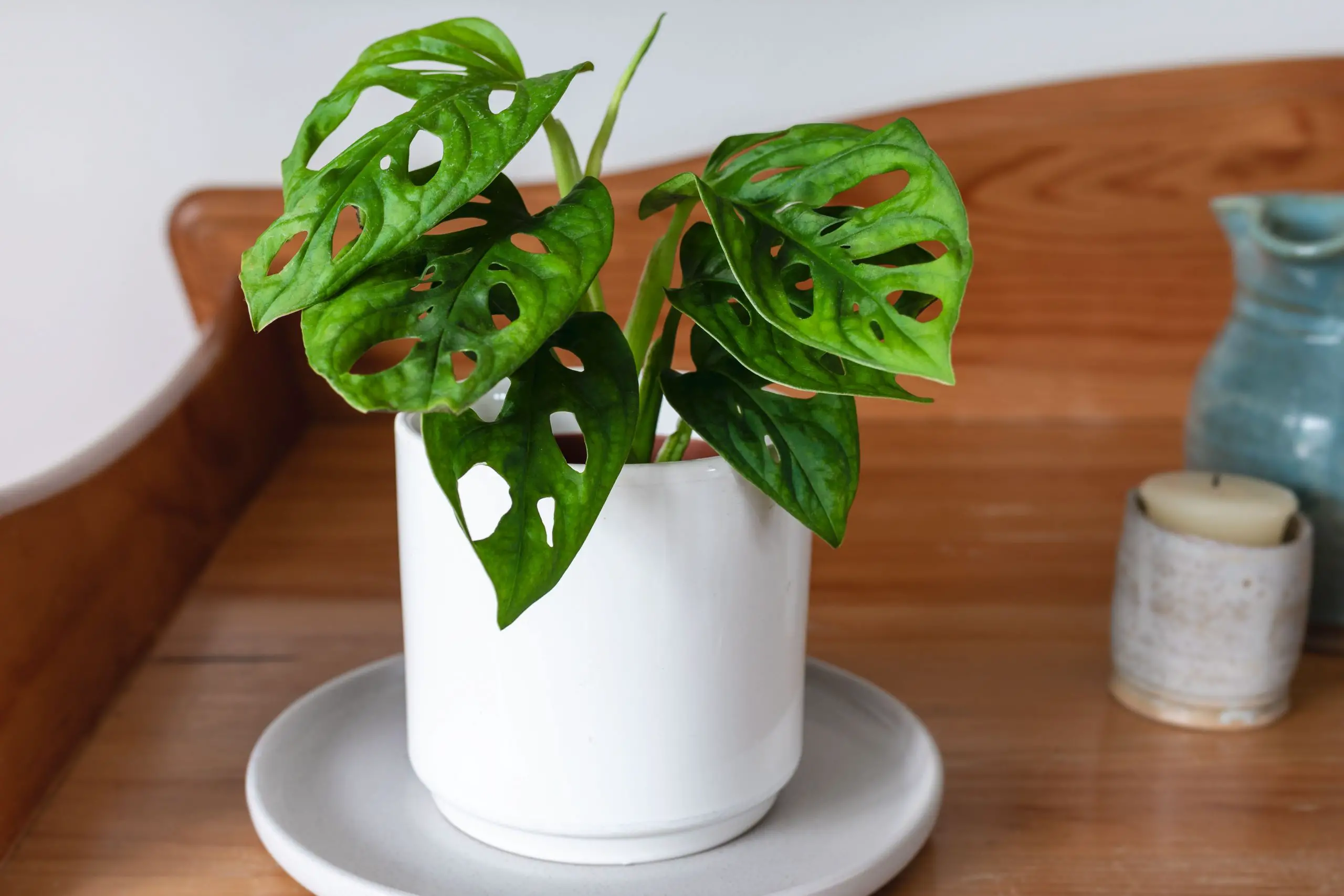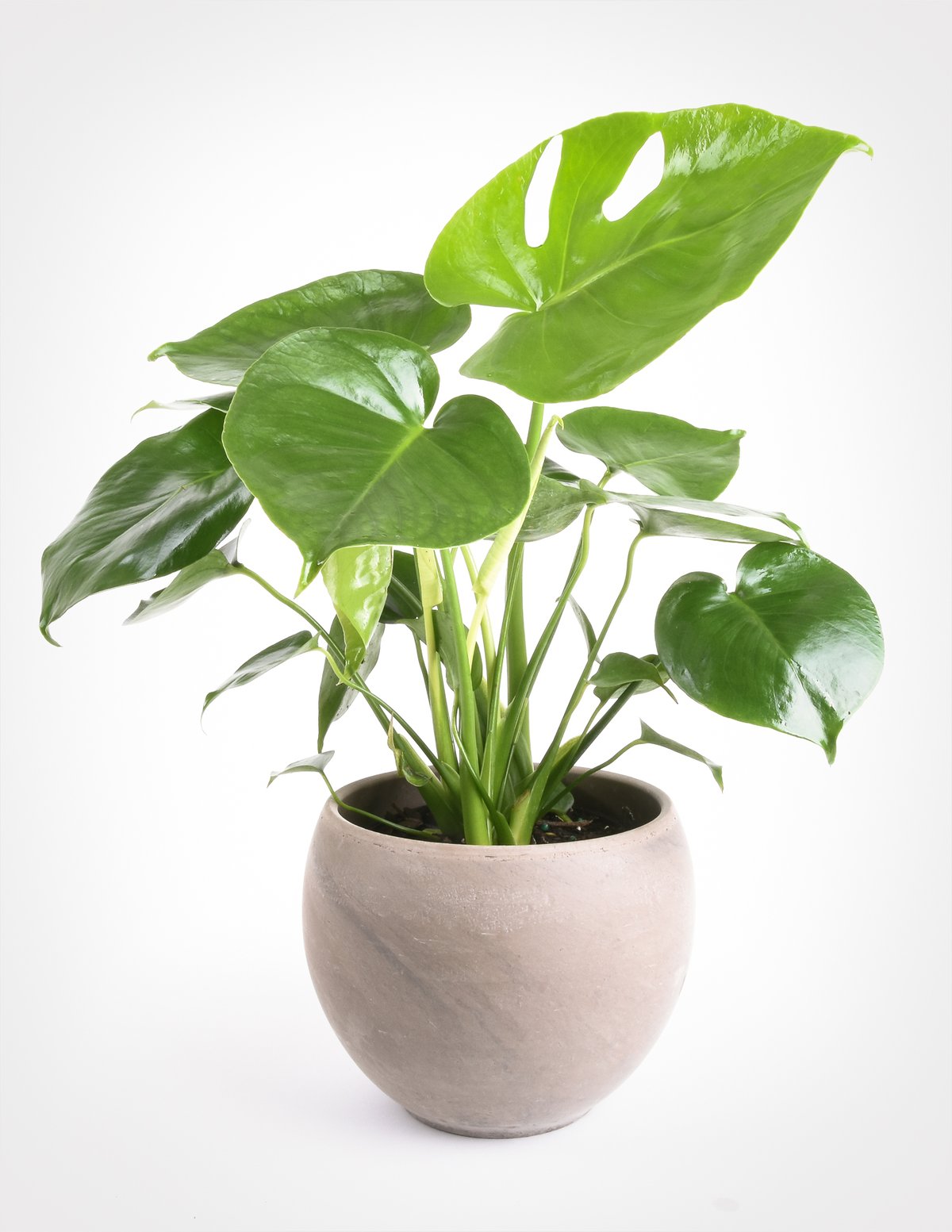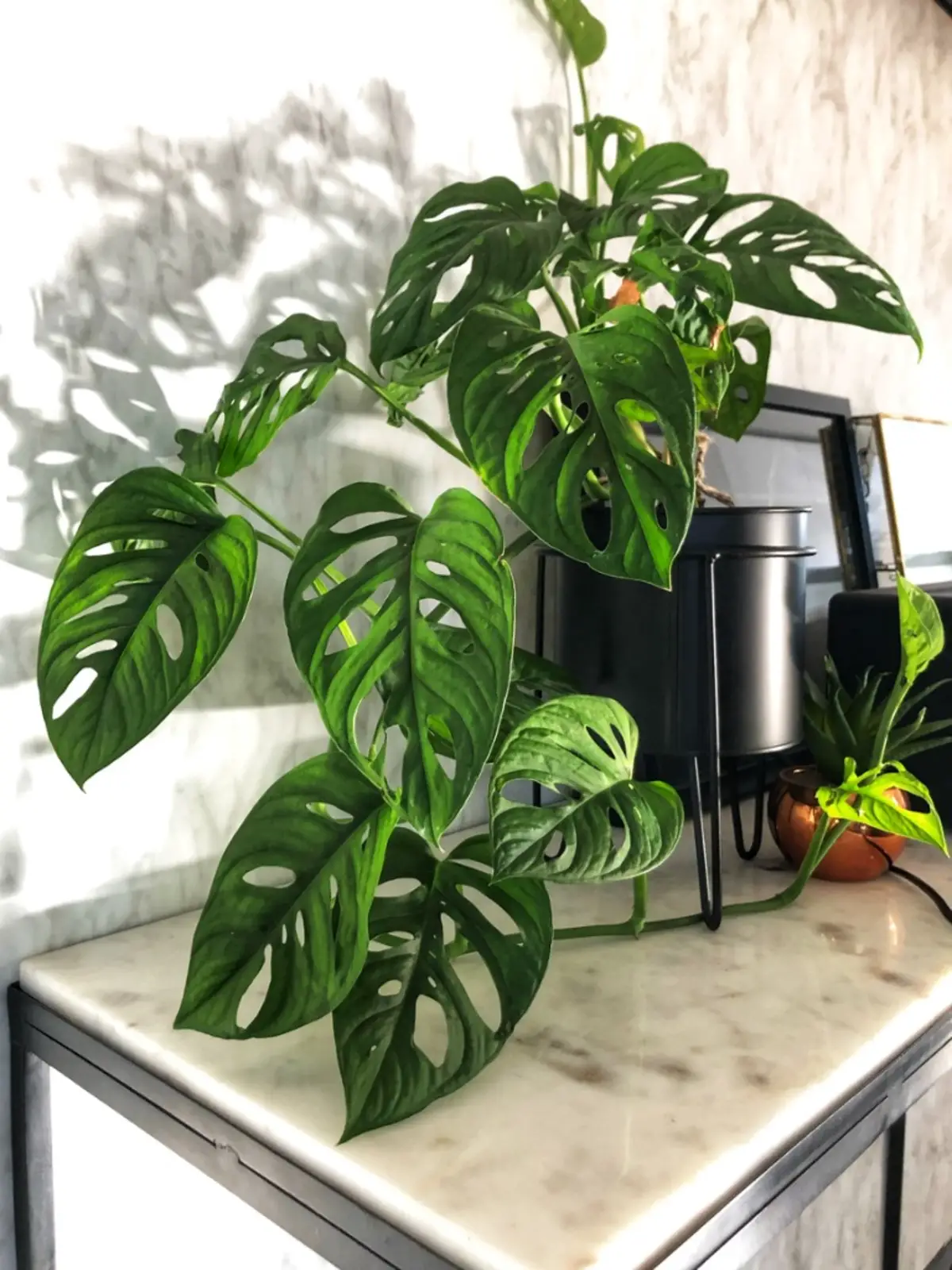Let Your Monstera Climb Up Or Trail Down
In the jungle, the Monstera adansonii plant grows long aerial roots, or air roots downward from the stem.
These above-ground growing aerial roots absorb moisture and nutrients from the air. And once they grow all the way down also from the soil.
The Monstera adansonii also uses its aerial roots to anchor itself and climb up tree trunks and branches of other plants and trees.
At home, give your plant something to grow onto. A stake or trellis, or a moss pole. Position the vines in a way that a few nodes underneath the leaves are close to the stake, or even touching it. The nodes is where the aerial roots will grow and climb onto the stake.
If you want to skip the whole stake thing, you can just put your Monstera adansonii in a hanging planter or on a pedestal plant table and let the vines trail down freely.
Root Monstera Adansonii Cuttings In Water
Cut a piece of vine, making sure the cutting has at least one or two nodes .
Take your cuttings and place them in a small vase filled with water. Put it in a spot where it gets lots of indirect light, and regularly refresh the water.
Next, wait. Roots will form within one to three weeks. When your cuttings have grown strong roots it is time to pot them in the soil.
Read More: Get all the water propagation tips and tricks to make lots of new plants for free!
Theres A Little Confusion About Exactly Which Monstera Plant Is Which
This is where it gets a little complicated! The plant category, or genus, is called Monstera, but several different species of Monstera go by the same common name of Swiss cheese plant. Mostly, youll find Monstera deliciosa, which has long-lobed leaves and elongated holes . Another similar plant, Monstera epipremnoides, looks almost identical except its leaves change from having holes to long slashes through the outer edges. And Monstera adansonii has heart-shaped leaves with holes. Regardless of which species you buy, theyre all beautiful, easy-care plants with similar needs.
Don’t Miss: Do You Need Reservations For Chuck E Cheese
The Name Might Sound Tasty But Its In Fact Inedible
The name Swiss Cheese Plant or Monstera Deliciosa may sound delicious, but dont be fooled This plant is in fact poisonous to people and animals. Although, Monstera Deliciosa does in fact mean delicious monster! The names are extremely fun and a real talking point for your plant collection.
Please read this guide to find out more about having certain houseplants in your home with animals and children.
This plant has a bunch of names
The Monstera Deliciosa is commonly referred to as Ceriman, Swiss Cheese Plant, Monstera, as well as The Mexican Breadfruit. Its name The Mexican Breadfruit comes from the rare occasions the plant has been known to produce fruits.
There are tonnes of names for this plant, you can find out more about the origins here.
How To Grow Swiss Cheese Plants Indoors

Most gardeners grow their Swiss cheese plants indoors. Its a great plant for indoors because it prefers low light. Dont plant it right in front of a sunny window. The leaves turn yellow when it gets too much sun. Place it away from the window. A north facing room is the best for this shade lover.
It wont get as large as it does outdoors, only growing to about 10 feet. Be sure to give it something to climb on! You can use regular potting soil. Water once a week at most. Allow the soil to dry out between waterings. Heres neat trick: if you get busy and cant water your plant regularly, you can take advantage of the fact that it has aerial roots and place one or more of the roots in a pot of water! It will take up the water through that root in addition to any watering you are doing in the pot. Our homes are very dry so mist your plant 2 to 3 times a week to provide humidity.
Fertilize 2 to 3 times a year with a balanced fertilizer as you would if you were growing it outdoors. You can prune your plant to keep it at a manageable size.
Don’t Miss: Which Cheese Is Keto Friendly
Are Cheese Plants Poisonous To Animals
The question many of us want to know when buying a plant is it pet-friendly? As so many of us houseplant lovers are also animal lovers, this can be make or break for a new member of our plant family.
Claire has the answers: Cheeseplants are poisonous if eaten, in fact most none-native plant species are toxic to pets, so we recommend keeping them out of the way of your animals and out of reach to alleviate the risks.
We suggest keeping it somewhere your furry friends wont get to. If youre too concerned however, it might be worth investing in a non-toxic plant instead.
Read more: Which of these common houseplants are toxic?
What Is The Growth Rate Of The Monstera Deliciosa
Our one-word answer: Quick. If you limit the space it has to grow, you can restrict this. However, if you want a bit of an epic Monstera, give it six-nine months and you can re-pot him into a bigger pot to help him grow bigger! When a new leaf arrives, this will come through in a lighter green colour. It will start all curled up, but will soon enough unveil itself and its holey cheese pattern will evolve in no time!
Recommended Reading: How Much Sodium In String Cheese
How Does It Work
Monstera deliciosae improve air quality in three ways:
Its been well-reported that nature is beneficial to our mental health. Though the connection between nature and wellbeing is strong, the reasons for this are purely theoretical: its generally accepted that we respond well to particular forms due to the way weve adapted on an evolutionary level.
For example, studies have shown that the colour green makes people feel alert and healthy, encouraging them to make better decisions, and feel more vibrant. Big green plants, like Monsteras, are therefore good to have in living rooms and offices as they help us feel energised and productive.
Check out – 7 Wellbeing Benefits of Indoor Plants
Note About Monstera Toxicity
Monstera tissue contains insoluble calcium oxalates essentially tiny, needle-shaped crystals so be sure to keep the plant away from your curious fur friends. According to the American Society For Prevention of Cruelty to Animals , if a dog or cat nibbles on Monstera, it can result in intense burning and irritation of the mouth, tongue and lips, excessive drooling, vomiting and difficulty swallowing.
Here’s a handy guide on how to keep trendy houseplants like Monstera happy and thriving.
You May Like: How To Cook Homemade Macaroni And Cheese
How Do I Choose The Correct Sized Decorative Pot To Fit My Houseplant
Check the grow pot diameter:
Determine the plant’s grow pot diameter. Compare this to the size of the opening of your chosen decorative pot and ensure it is big enough to insert the plant’s grow pot through the opening .
We show the size of the decorative pot openings for each pot as you click the different size options or hover over the size buttons.
Tip: Pick a decorative pot that has an opening about 1cm larger than the size of the plant’s grow pot. For smaller plants you should go slightly smaller and for larger plants you can add 2-3cm without the pot looking too large for the plant.
Note: If the shape of the planter tapers strongly at the base, it might not be wide enough for your plant to sit squarely at the bottom. In this case you can add a liner on a small layer of pebbles to increase the size of the base. This will however raise the height of the plant slightly in the planter.
For hydroculture plants use the size tip to select a decorative pot that will accommodate the waterproof liner recommended for the plant in the hydro kit.
Check the grow pot height:
Soil plants – The height of the grow pot can vary slightly, but is usually slightly smaller or the same as its diameter. Check your planter will be tall enough to hide the grow pot if you are not re-potting directly into the planter.
How To Care For Monstera Adansonii
For all its delicate beauty, growing Monstera adansonii is fairly straightforward. Plant it in a pot with drainage holes using a standard potting soil that contains peat. It will look best in a hanging basket or in a pot on a high shelf or somewhere else where its trailing vines can be shown off to advantage without getting in the way. Put the plant near a window where it will receive bright, but indirect, sunlight. Trim the vines as needed if they start to look scraggly to encourage new growth.
Watering is the trickiest part of caring for Monsteras. They like consistently moist soil but dont want to be soggy. They also like high humidity, which can especially be a challenge in winter, so consider using a humidifier. Yellowing leaves are a common issue and indicate that something about your watering schedule is off. Test the soil with a finger before you water: at least the top inch should be dry. On the flip side, make sure youre not giving it so much water that the top layer of soil remains wet for several days at a time. Watering once a week should do the trick, though you might need to experiment with frequency based on the temperature and humidity in your home.
Also Check: What’s The Best Mozzarella Cheese For Pizza
Keep It Away From Curious Pets
One caution: As with many tropical houseplants, Swiss cheese plant contains calcium oxalate crystals, which are toxic to pets. If you have cats or dogs that like to nibble, keep them away from this plant because ingesting it will irritate mouths, lips and tongues, and cause drooling, vomiting, and difficulty swallowing.
How Do I Make My Monstera Grow Faster

When it comes to maximising the size of your Plant and its leaves, make sure to provide it with the prime conditions mentioned above. They can grow like wildfire! They would typically climb on other plants in their wild environments, so you can also train your Monstera to grow up a trellis, moss pole or board to encourage height. You might be surprised to know that they can actually grow as high as 10 feet tall.
If the size is getting too much, feel free to cut it back theyre happily pruned! You could also make the most of your beautiful Plant by propagating it and gifting a new lovely Monstera to a friend. After all, theres nothing like receiving a new, beautiful Plant for your home.
Image courtesy of Unsplash. Photo by Beazy
Recommended Reading: What Time Does Chuck E Cheese Open On Sunday
How To Support Plants With Moss Poles
This is the most complicated kind of staking and is best for climbers that need support to grip onto. Examples include golden pothos vines, monstera, and climbing philodendron. A climbing pole can be made by filling a narrow wire tube with damp sphagnum moss and tying the plant to the pole until it latches on by itself.
Alternatively, some garden centers and specialty craft stores sell special climbing polls made from fern bark or moss that are designed for climbing plants. These stakes can be invaluable to growing a climber, but be aware that it will take extra moisture to keep the pole moist and encourage the plant to latch onto the stake. This is especially true for poles that use sphagnum moss, which dries out quickly.
Repotting Your Swiss Cheese Plant
We recommend repotting your Swiss Cheese plant once a year while its growing. This gives the plant both plenty of space and enough nutrients to grow.
Repotting is best done in very early spring just before new leaves start to grow.
Choose a pot that is around 5cm bigger in diameter and make sure it has plenty of good drainage holes. You want to avoid selecting a pot any large than this as it can lead to waterlogged soil when watering.
Once your plant has reached optimal height for your space, you can renew the soil in the pot by giving it a top dressing every year and then repotting and renewing soil every 3 years thereon after.
As your plant grows larger, ensure that you add a trellis or moss pole that it can start to climb. If one isnt added, your swiss cheese may start growing wider and more spindly.
Read Also: How To Make Mac N Cheese Healthier
How To Grow Swiss Cheese Plant From Seed
To grow a Swiss cheese plant from seeds, plant them in a shallow tray filled with a moistened seed-starting mix. Lightly cover the seeds with the growing medium. Put plastic wrap over the tray to trap in moisture, and place it in a warm spot with bright, indirect light. Mist the growing medium to keep it lightly moist. The seeds should germinate in a few weeks. After that, remove the plastic wrap but continue to keep the growing medium moist. The seedlings should be large enough for transplanting in a few months.
What Are The Uses Of The Swiss Cheese Plant
Aside from being popular as a houseplant creating an instant tropical, jungle vibe, this monstera is a known medicinal and culinary plant. The pulp from the flower is used to treat skin spots, rough and dry skin, and pimples.
The floral spathe is also used as wound or bruise dressing. The aerial roots can also be fashioned into ropes to create baskets .
In the wild, the plant will bloom in its third year and the resulting fruit ripens within a year. The flower heart can be eaten raw, described to taste like guava, pineapple, granadilla, and banana, all at the same time, giving this monstera another namefruit salad plant.
You May Like: How To Make Easy Cheese Sauce
How Much Humidity Does A Monstera Need
As a native of Central American tropical climates, they also prefer more humid conditions. They will live quite happily in a normal home environment, but to keep them extra healthy, you could always up the moisture in the air.
Moving it to a room with lots of moisture such as a bathroom or kitchen can be a good solution for this. But if thats not possible, a cheap, quick and easy way to up the humidity is by lightly dusting the leaves with a misting bottle once a day.
If youre able to splash some cash, almost all houseplants will benefit from a humidifier so its worth the investment. Use it throughout the winter months to keep your houseplant health optimal. They produce steam consistently to add extra humidity to the air great for those of us that love more tropical climates too!
Image courtesy of Unsplash. Photo by Huy Phan
How Large Do Swiss Cheese Plants Grow
The Swiss cheese plant gets its scientific name, Monstera, in part because of how large it can grow. In their natural jungle habitat, these plants can grow to be 10 feet tall, with leaves that spread two feet wide. This is generally too large for most homes, butSwiss cheese plants respond well to regular pruning, which can help keep them to a manageable size.
You May Like: Where To Buy Smoked Gouda Cheese
Swiss Cheese Plant Propagation
The Swiss cheese vine plant can be propagated through seeds, stem cuttings, or suckers, with cuttings or suckers more common.
If you are wondering how to take Swiss cheese plant cuttings, it is easy. For this Swiss cheese plant propagation, just take stem cuttings, with a section of the stem remaining, by cutting just after a leaf node. Remove the first leaf near the base of the cutting, and plant the node within the soil. You can use rooting hormone if desired, but this isnt necessary. Water well, allowing it to drain out. Ideally, you may want to root the cutting in water beforehand, moving it to a pot once rooting has adequately begun taking place. Root the cutting of Swiss cheese vine plant in water for about two to three weeks, then transfer to a pot filled with rich potting soil.
You can also do Swiss cheese plant propagation by wrapping damp moss around the stem at a small aerial root and leaf axil, holding it in place with string. Enclose this section in a clear bag, tied off at the top . Within a few months, new roots should begin to develop on the Swiss cheese vine plant.
How Does The Swiss Cheese Plant Care For You

The Cheese Plant does not smell like cheese luckily. Living with houseplants, practicing active plant care and building a relationship with nature has been shown to benefit our health in a variety of ways. All plants have the potential to do this, but some are more adept than others, depending on their formal or chemical characteristics.
Benefits of the include improving the quality of the air you breathe, inducing feelings of calm, trapping dust and helping you feel alert.
Recommended Reading: What Is The Best Cheddar Cheese